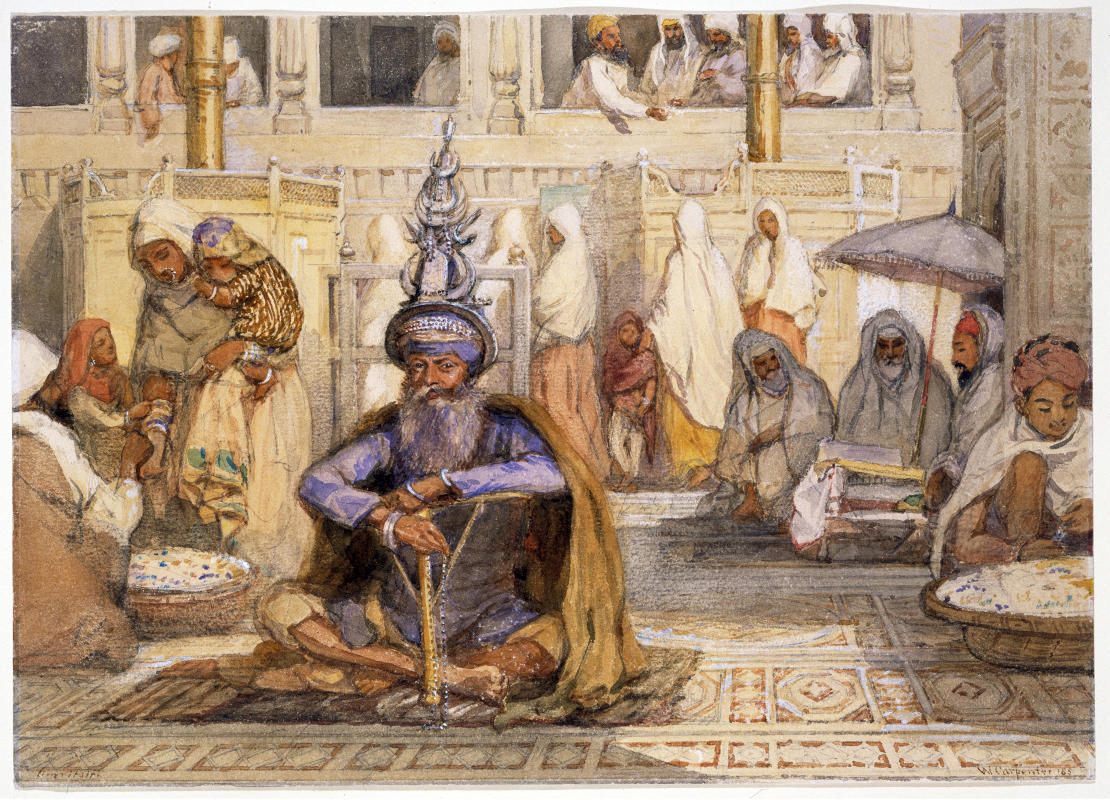An Akali Sikh seated near the Golden Temple, Amritsar, Punjab, India, 1854.
|
|
 A larger image of an Akali Sikh seated near the Golden Temple, by William Carpenter, Amritsar, Punjab, India, 1854. |
|
|
 A larger image of an Akali Sikh seated near the Golden Temple, by William Carpenter, Amritsar, Punjab, India, 1854. |
This watercolour shows an Akali Sikh sitting near the causeway to the 'Golden Temple' or Har Mandir in Amritsar, the principal temple of the Sikhs. The Akalis were a militant sect easily recognisable by their tall conical turbans decorated with quoits and metal ornaments. The artist, William Carpenter, was the son of William Hookham Carpenter, Keeper of Prints and Drawings in the British Museum, and the portraitist, Margaret Sarah Geddes. He went to India in 1850 to paint portraits and made studies of scenery and daily life, remaining there for seven years. He was in Amritsar in 1854 and there painted views of the Golden Temple. Carpenter exhibited his watercolours in the South Kensington Museum (now the V&A) in 1881 and the Museum has a large collection of his work. This painting was one of 134 by Carpenter bought by the Museum in 1882. Other Carpenter watercolours had been acquired in 1881 and another was acquired in 1885.
Physical description: Watercolour painting. An Akali Sikh, dressed in blue, is shown sitting near the causeway to the Golden Temple in Amritsar. He is recognisable as an Akali by his tall conical turban decorated with quoits and metal ornaments. Numerous other figures, male and female, can be seen in the background.
Place of Origin: Amritsar, India (made)
Date: February, 1854 (made)
Artist/maker: William Carpenter (maker)
Materials and Techniques: Watercolour on paper
Dimensions: Height: 9.875 in sight measure, Width: 13.75 in sight measure
Object history note: The artist, William Carpenter, was the son of William Hookham Carpenter, Keeper of Prints and Drawings in the British Museum, and the portraitist, Margaret Sarah Geddes. He went to India in 1850 to paint portraits and made studies of scenery and daily life, remaining there for seven years. This painting was one of 134 by William Carpenter bought for a total price of £500 in 1882 following an exhibition of his work in the South Kensington Museum in 1881. Other Carpenter watercolours had been acquired in 1881 and another was acquired in 1885.
Labels and date:
. 8.AN AKALI SIKH SEATED NEAR THE GOLD [sic] TEMPLE
. By William Carpenter (1818-99)
. Watercolour on paper
. Amritsar, Panjab, 1854
. An Akali Sikh is shown sitting near the causeway to the Golden Temple in Amritsar. The Akalis were militant zealots easily recognisable by their tall conical turbans decorated with quoits and metal ornaments. The artist, William Carpenter, was the son of William Hookham Carpenter, Keeper of Prints and Drawings in the British Museum, and the portraitist, Margaret Sarah Geddes. He went to India in 1850 to paint portraits and made studies of scenery and daily life, remaining there for seven years.
Materials: Pencil; Watercolour
Museum number: IS.41-1882
Source: Victoria and Albert Museum